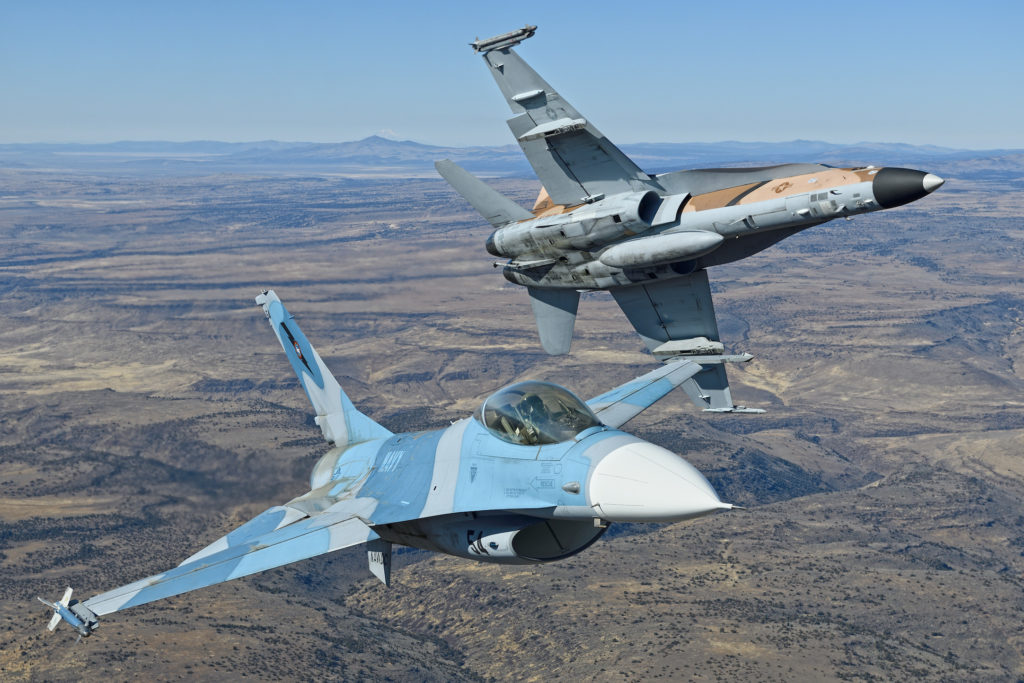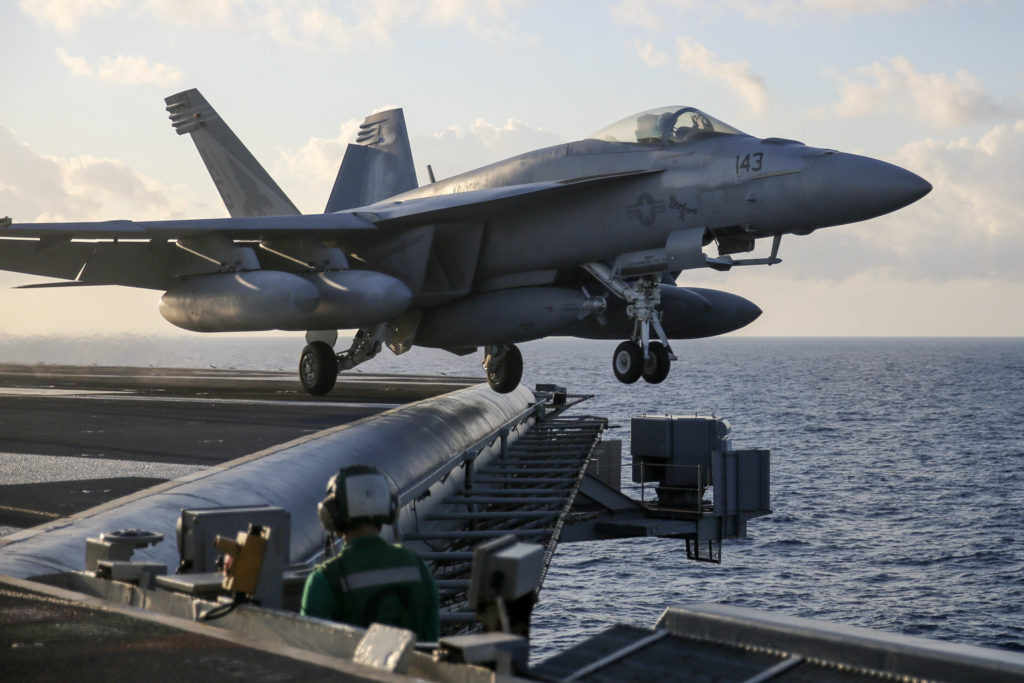Estimated reading time 12 minutes, 40 seconds.
Mention the word “TOPGUN,” and many will cite the 1986 Hollywood blockbuster movie starring Tom Cruise as Lt Pete “Maverick” Mitchell — a rebellious and talented young U.S. Navy fighter pilot. As the world eagerly awaits the COVID-delayed release of the forthcoming sequel, the real TOPGUN — formally known as the Navy Fighter Weapons School — quietly goes about its highly professional business in northern Nevada.
Both the big Grumman F-14 Tomcat and TOPGUN itself achieved world notoriety thanks to the famous movie. TOPGUN represents the pinnacle of fighter aviation within the U.S. Navy, and a high achieving Royal Canadian Air Force (RCAF) aviator has just made history by graduating from this esteemed and challenging course. Capt Chris “LIME” Swartz graduated from the Strike Fighter Tactics Instructor (SFTI) program, more popularly known as TOPGUN, on Nov. 24, 2020 — at the culmination of a gruelling syllabus that involves many hours of ground school and some of the most challenging live flying to be found anywhere on the planet.

Swartz is in the U.S. flying the F/A-18E Super Hornet as part of an exchange program with the Navy. Having joined the RCAF in 2006, and earning his pilot wings in 2012, Swartz completed fighter lead-in training in 2014. Afterwards, he was posted to 425 Tactical Fighter Squadron (TFS) in Bagotville, Que., in 2015, flying the CF-188. He subsequently deployed on Operation Reassurance in Germany and Operation Impact in Kuwait.
By 2017, he had started an exchange tour and completed F/A-18E Super Hornet training with the Fleet Replacement Squadron (FRS) at Naval Air Station Oceana, Virginia, and was posted to U.S. Navy Strike Fighter Squadron 143 (VFA-143) “Pukin’ Dogs” at Oceana. As part of Carrier Air Wing 7 (CVW 7), the squadron completed a 10-month operational deployment aboard the USS Abraham Lincoln (CVN 72) aircraft carrier from April 2019 until January 2020, which became the longest carrier deployment since the Vietnam War. Swartz said “launching off a carrier is like nothing else, it’s a crazy ride. I am very thankful to the Landing Signal Officers [LSOs], whose support and training were instrumental in getting me up to speed on carrier operations, and in recovering the aircraft back aboard the boat safely.”
Selected for TOPGUN
Swartz made such an impression with his chain of command at VFA-143 that he was nominated, and then selected, to take part on the prestigious TOPGUN course. The course is run as part of the Naval Aviation Warfighting Development Center (NAWDC) at NAS Fallon, Nevada. TOPGUN runs three 13-week SFTI courses each year for students who are hand-picked from fleet squadrons. It typically involves around 15 students per class, some of whom then go back to the fleet to raise the level of instruction and standards in the respective units, while others can remain at Fallon to become TOPGUN instructors.

The SFTI course is dedicated to maintaining standards across the U.S. Navy and is aimed at pilots, weapons systems officers (WSOs), and intelligence officers. With the F/A-18C “Legacy” Hornet now retired from the front-line Navy fleet, F/A-18E/F Super Hornet aviators comprise the majority of students attending the course. In 2020, TOPGUN added the new Lockheed Martin F-35 Lightning II to its syllabus, heralding one of the biggest advances ever in its 51-year history as it introduced the new stealthy strike fighter.
TOPGUN was established in 1969 at NAS Miramar, Calif., as a response to a report led by Capt Frank Ault, that was commissioned to investigate aerial combat in the Vietnam War. Air-to-air “kill” ratios in previous air wars saw statistics of around 12:1 in favor of U.S. fighters. In Vietnam, however, from 1965 through to late 1968, that Navy kill ratio dropped to just 3.7:1. The report found that training across the U.S. Navy was below par, and Ault recommended the establishment of a fighter weapons school.
TOPGUN started out teaching individual 1-v-1 aerial combat during a four-week program. The evolution of naval fighter aviation saw TOPGUN expand to include air-to-ground elements, becoming a strike fighter course in 1995 to reflect the multi-role missions of more modern fighter aircraft. Yet, to this day, TOPGUN remains heavily weighted towards air-to-air tactical training. In summer 1996, TOPGUN moved from its ancestral home at Miramar, north to Fallon, where it remains today.
The TOPGUN course
Unlike the original movie, there is no actual competition between the students — this is about living up to the extremely high standards that are set here and maintain the quiet professionalism that goes hand-in-hand with the mystique of TOPGUN. Those attending the TOPGUN course must have completed a fleet tour and be a division (four-ship) flight lead.

The course starts with 1-v-1 basic fighter maneuvers (BFMs), before moving through section (two-ship) and division (four-ship) air-to-air missions, with a further section dedicated to air-to-ground tactics. All phases are conducted at Fallon, except for BFM, which involves TOPGUN sending a detachment of students and instructors to either NAS Lemoore or MCAS Miramar in California, or NAS Oceana, Virginia.
Every flight is carefully scrutinized by the TOPGUN staff, ensuring that the students meet the high standards of the course. Upon graduation, they receive the coveted TOPGUN patch, which illustrates their abilities not just as a pilot, but also as a teacher who can go back to the fleet and help raise the overall standard.
As part of Swartz’s virtual graduation ceremony, RCAF MGen Michel Lalumiere expressed pride and excitement for Swartz’s success. Lalumiere congratulated the graduates of TOPGUN Class 01-21, and commended all participants for their hard work and dedication. He also spoke of the deep relationship shared by Canada and the U.S. at every level.

Reflecting on his time at TOPGUN, Swartz commented: “The instructors brief, fly, and debrief with us. Not only are they some of the best fighter pilots in the world, but they are also some of the best teachers and instructors I have had the privilege to learn from. Their professionalism and dedication to the training and development of Navy and Marine Corps aviators are second to none, and I was deeply honoured to have had the opportunity to fly and learn from such an amazing group. The instructors there are the reason the TOPGUN brand carries such a strong reputation throughout the U.S. military, and among allied partners.”
Reflecting on the experience of undertaking the prestigious TOPGUN course, Swartz said learning from “U.S. Navy subject matter experts regarding various tactical aviation subjects” was invaluable. He noted that the opportunity to see “how they develop, evaluate, and publish tactical execution standards, and continuously revise and update these publications to ensure Navy and Marine Corps aviators remain the best in the world, shows just how much work these guys do.”

Skills carried forward
Both Swartz and an Air Combat Systems Officer (ACSO) are currently on exchange with the U.S. Navy, with two additional aircrew — another pilot and an ACSO — who are currently on exchange with the Royal Australian Air Force (RAAF). These postings are in place to help the RCAF gain experience with advanced fighter aircraft in order to help facilitate the introduction of a new fleet in Canada under the Future Fighter Capability Project (FFCP). The ongoing competition includes the Super Hornet, as well as the F-35A, and the Saab Gripen E.
FFCP is the RCAF’s largest acquisition in 30 years, and it plans to leverage the experience gained by the four exchange officers to help facilitate preparations and planning for the introduction of the advanced capabilities of a modern fighter aircraft.

Swartz is scheduled to consolidate his training with the U.S. Navy by returning to VFA-143 as a training officer. This Active Posting Season (summer 2021), he and his wife will be returning to Canada, where Swartz is scheduled to commence working in the Fighter Capability Office. Few opportunities in fighter aviation are as rewarding as Swartz’s time at TOPGUN, and he will undoubtedly wear the famous TOPGUN patch with great pride as he helps carve out the future of RCAF fighter aviation.









Amazing! Great job Lime – you make us proud.
Congrats from all us proud Canadiens .
Congratulations! I hope to see you fly someday!
Congratulations Lime! You make Canada look good- maybe you could get them to straighten up and fly right! Excellent article and all the best for a wonderful Christmas holiday and all the best to you and Top Gun future endeavours. Onward and upward.
But did you get to buzz the tower??
Congratulations and well deserved, Captain Swartz!
@skiesmag.com how many Canadian RCAF aviators have participated in this prestigious training event? If there have been others, what aircraft did they utilize in years past?
Again, congratulations to all participants. Wishing you all a merry Christmas and a safe, happy and healthy new year!
That’s badass. We are proud of you Capt Chris “LIME” Swartz!
Very proud of your accomplishments. You are one to be looked up too!
Canadians too, eh?
You make me proud to be a Canadian
Congrats!! OH CANADA!! WE are amongst the best. Fly that maple leaf. Thank you for your service.
Congratulations Chris! From Your American Cousins Eugene and Susie! God bless you as you continue on in your great adventure!
Thanks for serving our country and our friends. Congratulations.
Capt. Chris Swartz,
I’m glad l read this article and we’re very proud of you. I hope they won’t hold it against you when we chose the Gripen E as our new fighter jet. It’s the best at what it does, and from what l have read you are going to love it. All the best.
Kindest Regards,
Paul Witham
Captain LIME, do not listen to Paul Witman. He does not understand that what 5th generation technology brings to the table. CONGRATS on your performance.
-Tim MacKay
Congrats! Now the only thing missing for Canada are a couple aircraft carriers.
Good thing we have a new Navy Chief of Defence Staff…
Food for thought!
Awesome Lime!!
You are the hero for our next gen!
Bravo Zulu Sir! Canada Proud!
Congratulations Chris; and thank you.